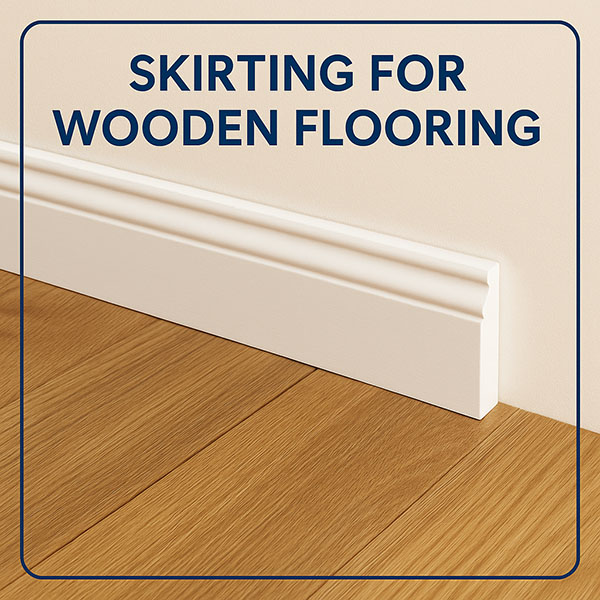Choosing Skirting for Wooden Flooring – The Complete Guide
When it comes to finishing your wooden or laminate flooring, the right skirting can make all the difference. Skirting boards, also called baseboards, add the perfect finishing touch by covering gaps between the floor and the wall, protecting walls from scuffs, and enhancing the overall look of a room. But with so many options, how do you choose the best skirting for wooden flooring? This guide will walk you through everything you need to know materials, styles, heights, colors, installation tips, and more.
Why Skirting Matters for Wooden Flooring
Skirting is more than just decoration. It hides expansion gaps left around wooden or laminate floors, protects walls from cleaning equipment or furniture, and helps create a polished look. Whether you’re working with natural wood, laminate, or vinyl flooring, skirting adds durability and style. Choosing the right profile and material ensures your flooring project looks complete and lasts for years.
Types of Skirting for Wooden Flooring
There are three main materials commonly used for skirting: MDF, natural wood, and PVC. Each has unique advantages depending on your flooring type, budget, and style preference.
| Material | Advantages | Considerations |
|---|---|---|
| MDF Skirting | Affordable, smooth finish, easy to paint | Not as durable in damp conditions |
| Wooden Skirting | Premium look, natural grain, long-lasting | More expensive, needs regular maintenance |
| PVC Skirting | Waterproof, lightweight, budget-friendly | Limited style options compared to wood |
Choosing the Right Skirting Height
The height of your skirting can change the feel of a room. For standard rooms, 70mm–90mm is common. Higher ceilings can benefit from 120mm or even 150mm skirting for added impact. If you’re installing laminate floors, make sure the skirting height complements the plank size to keep the proportions balanced.
Color and Finish Options
Traditionally, skirting is painted white to contrast walls and floors. However, modern designs often use color-matched skirting for a seamless effect. You can also opt for glossy finishes for a clean, polished style, or matte finishes for a natural, understated look. Consider the color of your wooden or laminate flooring price range to ensure harmony in your design.
Popular Skirting Profiles
- Bullnose skirting – smooth and rounded, simple and versatile
- Torus skirting – traditional curved design, works well in classic interiors
- Chamfered skirting – clean angled edge, popular for modern homes
- Ogee skirting – ornate and decorative, ideal for heritage homes
How to Install Skirting with Wooden Flooring
Installing skirting boards is the final step after laying your floor. Follow these tips to achieve a professional finish:
- Ensure your floor has fully settled before fitting skirting.
- Measure and cut boards carefully, using a miter saw for corners.
- Use adhesive or screws depending on the wall type.
- Seal the edges neatly with caulk or filler for a smooth finish.
If you’re unsure, it’s best to hire professional installers. Visit our Laminate Floor World homepage to request a quote or book a consultation.
Maintenance Tips for Skirting Boards
Keeping your skirting clean ensures it looks fresh for years. Regular dusting and occasional wiping with a damp cloth is usually enough. For painted skirting, avoid harsh chemicals. Wooden skirting may need refinishing every few years, while PVC and MDF are virtually maintenance-free.
Design Ideas with Skirting
Skirting can also be a design feature. Tall skirting painted in bold colors adds drama, while minimalist low skirting blends into modern interiors. Matching your skirting to door frames creates a seamless flow throughout your home. When paired with vinyl flooring, sleek PVC skirting creates a waterproof, practical finish for bathrooms or kitchens.

Frequently Asked Questions (FAQ)
What is the best skirting for wooden flooring?
MDF is cost-effective and easy to paint, while natural wood offers a premium look. PVC is best for wet areas. The right choice depends on your budget and room conditions.
What height should skirting be for laminate floors?
Most skirting is between 70mm and 120mm. Higher ceilings suit taller profiles, while smaller rooms benefit from lower skirting to avoid looking cramped.
Can you replace skirting without removing the floor?
Yes, skirting can usually be replaced without lifting the floor. Careful removal and fitting ensure your flooring is not damaged in the process.
Should skirting match the floor or the wall?
It depends on your style. Matching the floor creates a seamless look, while matching the wall creates a bold contrast. Both approaches are common in modern interior design.
Do you need skirting with vinyl flooring?
Yes. Even with vinyl flooring, skirting helps cover expansion gaps and adds a neat finish. PVC skirting is the most popular choice for moisture-prone areas.
Final Thoughts
Skirting is the finishing touch that brings your flooring project together. From affordable MDF to premium wood or waterproof PVC, there’s an option for every style and budget. By choosing the right height, finish, and profile, you can elevate the look of your home while protecting your walls and floors. For expert advice, pricing, and installation, explore our laminate flooring collection or visit the Laminate Floor World homepage today.

Leave a Reply